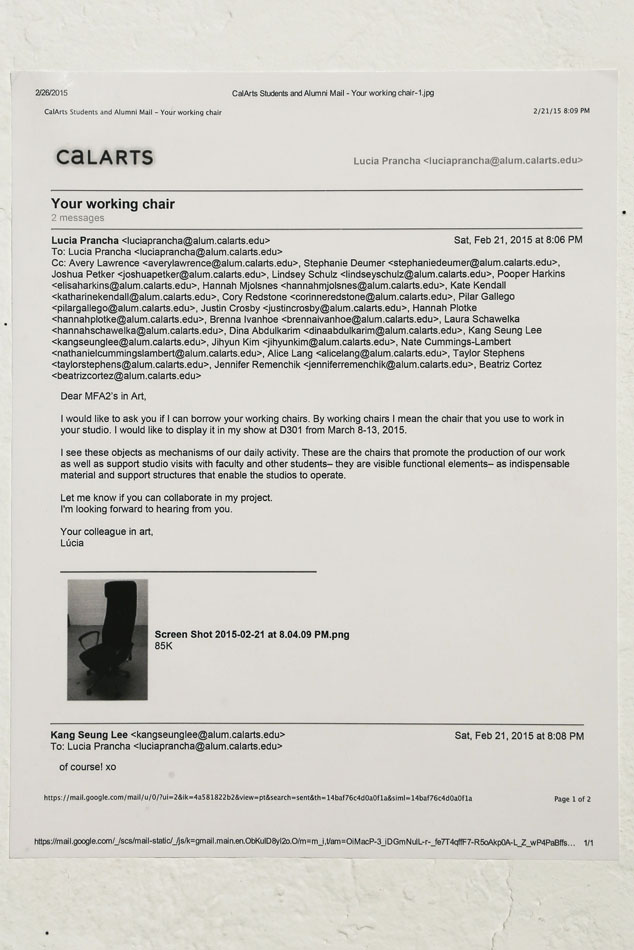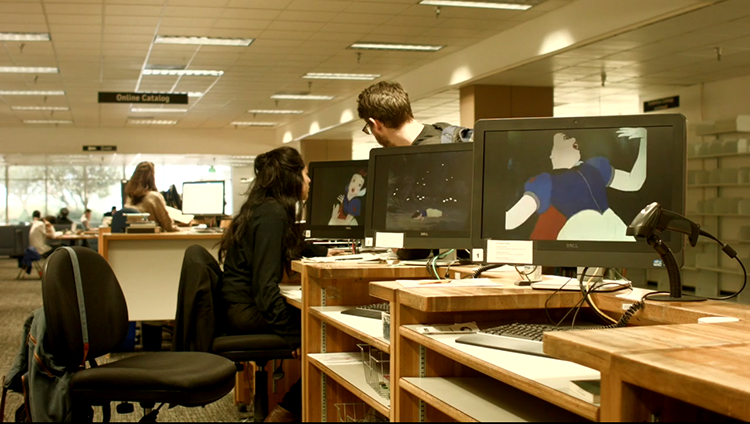

Your Working Chair, 2015. Borrowed chairs of some of my MFA colleagues. 15 chairs, 1 rocking chair, 2 stools, 1 blanket, e-mail printed. Dimensions variable.
Dream Work, 2015. Printed basic combed cotton, silk thread, black curtain clips w/ hook. 64” x 213”
The project takes the form of an installation, an exhibition constituted by two works exploring the idea of site-specificity, artistic production, strike, the social and work dynamics as well as the intricate relations between production and consumption.
In YOUR WORKING CHAIR (2015) I borrow my peers working chairs. By working chairs I mean the chair that they use to work in their studios. And display it in my show at D301 from March 9-14, 2015. I see these objects as mechanisms of our daily activity. These are the chairs that promote the production of our work as well as support studio visits with faculty and other students– they are visible functional elements– as indispensable material and support structures that enable the studios to operate.
DREAM WORK (2015) brings things together that don't seem ready to be. It's a suspended 6 yard curtain that divides the space using the photoshop checkered as background for an image of the artist (me) sleeping in the studio. A superimposition by a series of images based on the importance of the unconscious mind as an latent archive composed by ghostly manifestations.

The Haunted Screensavers, 2014. Two screensavers.
The work explores how an altered context informs social relations and actions. The consideration of structural elements as language
of a space, thus in sitespecific interventions, the manipulation of library computer screens as structures to deconstruct socially defined spaces and their uses, their history and playful possibilities. By way of appropriation, repetition, and from the ideas left by the –almost gone– Institutional Critique movement, I drew an almost invisible situation that suggest alternative perceptions of a place.
Starting from the context of CalArts library, as a marginal space to present art, I came with the idea of an intervention in the computers–a screensaver–The Haunted Screensavers (2014). Two screensavers: one minute scene of the haunted forest from “Snow White and the Seven Dwarfs” (1936) directed by Walt Disney, and the other one, three second gif taken from the internet a series of cartoon eyes blinking in the dark. This one recalls the eyes that haunt Snow White. Both screensavers were installed alternately on each computer at the CalArts Library for one day (December 11, 2014). The conceptual point of departure for this interventions at the library, came from my interest in art outside of the usual exhibitions spaces, art that doesn’t look like art and the play with ideas such as structures, meaning and functionality.
The screensaver is a computer program that blanks the screen or fills it with moving images or patterns when the computer is not in use. I’m interested in explore the space of non work, the space of sleep, therefore the screensavers computer and the possibilities of an machine’s unconscious/mind. The specific event addresses the library with an attempt to highlight the interface between the binaries: real/fiction, physical/digital and interior/exterior spaces.
Almost imperceptible, the screensavers lurk in the computers as haunted parasites.
With this intervention at the CalArts Library, I mixed fictional fragments, the overlap of historical and contemporary contexts and relational elements to address as well as symbolic escape routes from the everyday and the use of common spaces.
In both directions the students and library visitors are revealed to be the protagonists who complete the work.